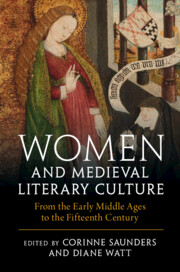Book contents
- Women and Medieval Literary Culture
- Women and Medieval Literary Culture
- Copyright page
- Contents
- Illustrations
- Contributors
- Acknowledgements
- Introduction
- I Patrons, Owners, Writers, and Readers in England and Europe
- II Circles and Communities in England
- III Health, Conduct, and Knowledge
- IV Genre and Gender
- V Women as Authors
- Chapter 18 Marie de France
- Chapter 19 Julian of Norwich
- Chapter 20 The Communities of The Book of Margery Kempe
- Chapter 21 Christine de Pizan
- Chapter 22 Beyond Borders
- General Index
- Index of Manuscripts
- References
Chapter 20 - The Communities of The Book of Margery Kempe
from V - Women as Authors
Published online by Cambridge University Press: 28 July 2023
- Women and Medieval Literary Culture
- Women and Medieval Literary Culture
- Copyright page
- Contents
- Illustrations
- Contributors
- Acknowledgements
- Introduction
- I Patrons, Owners, Writers, and Readers in England and Europe
- II Circles and Communities in England
- III Health, Conduct, and Knowledge
- IV Genre and Gender
- V Women as Authors
- Chapter 18 Marie de France
- Chapter 19 Julian of Norwich
- Chapter 20 The Communities of The Book of Margery Kempe
- Chapter 21 Christine de Pizan
- Chapter 22 Beyond Borders
- General Index
- Index of Manuscripts
- References
Summary
Anthony Baleߣs essay takes up recent scholarship on the historicity and production of The Book of Margery Kempe and on international influences on Kempeߣs piety and devotional practices. He argues that while the Book itself presents Kempe as an outsider, repeatedly repudiated by communities, and as disruptive, a ߢqueerߣ influence, collaboration is central to it. The essay recovers three earthly communities with which Kempe and her Book successfully engaged: Franciscan, Bridgettine, and monastic, considering questions of literacy, education, and cultural prestige. Kempeߣs experience in the Holy Land, Bale shows, was indebted to her integration into the Franciscan-led pilgrimage community, where she ultimately gained a high and holy reputation. The essay demonstrates that Bridgettine communities and patronage networks in Rome and at Syon also shaped Kempeߣs spiritual experience, while in Norfolk, a textual community including preachers and confessors formed around her. Following Kempeߣs death, manuscript annotation and printing history suggest a community of engaged readers who responded affectively to her spirituality.
Keywords
- Type
- Chapter
- Information
- Women and Medieval Literary CultureFrom the Early Middle Ages to the Fifteenth Century, pp. 420 - 437Publisher: Cambridge University PressPrint publication year: 2023



